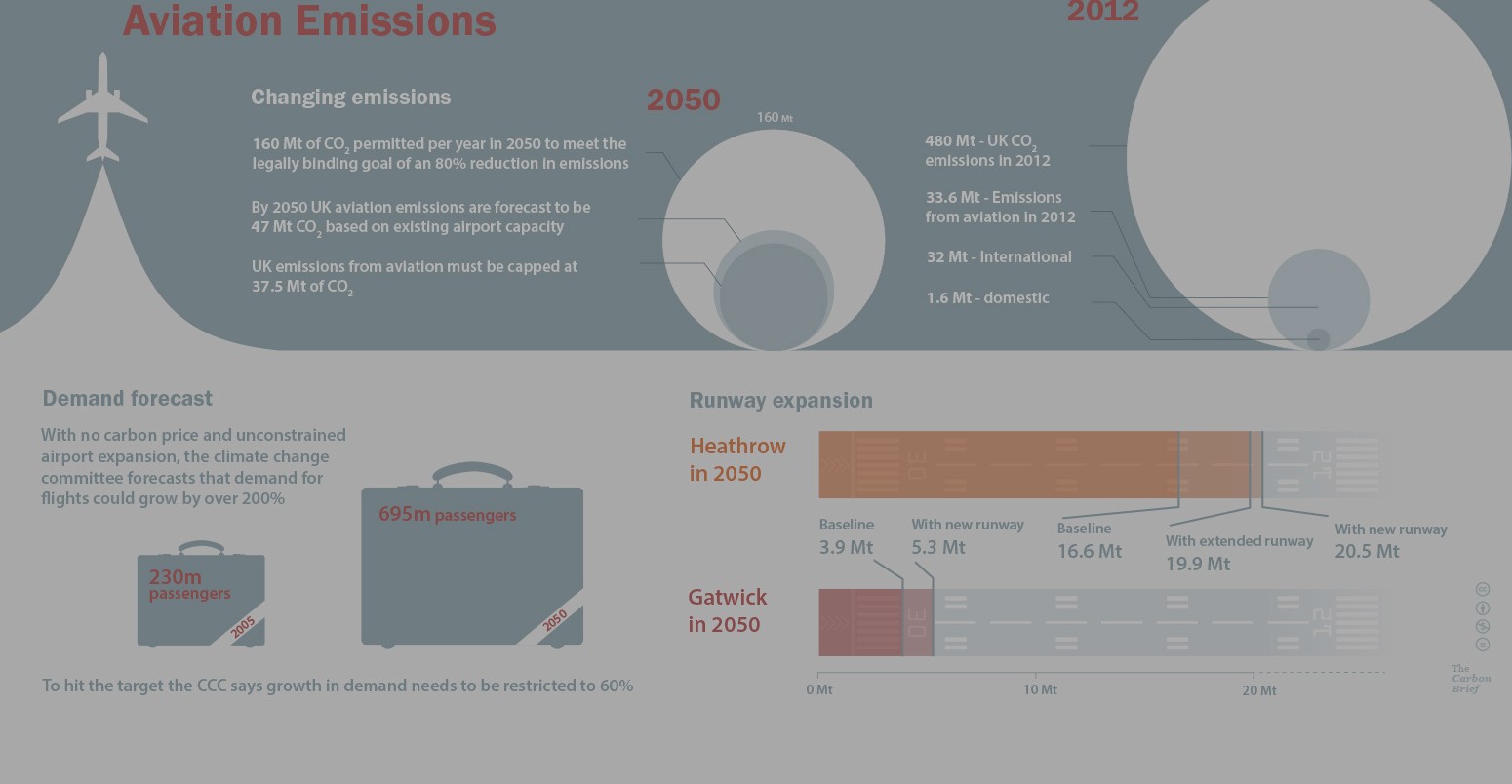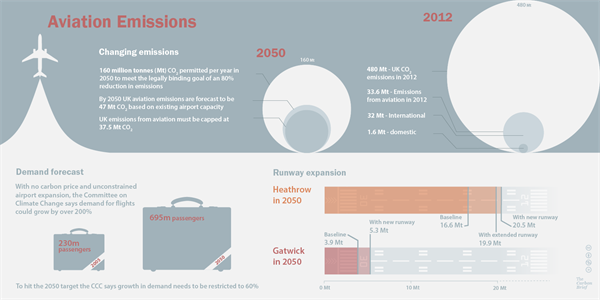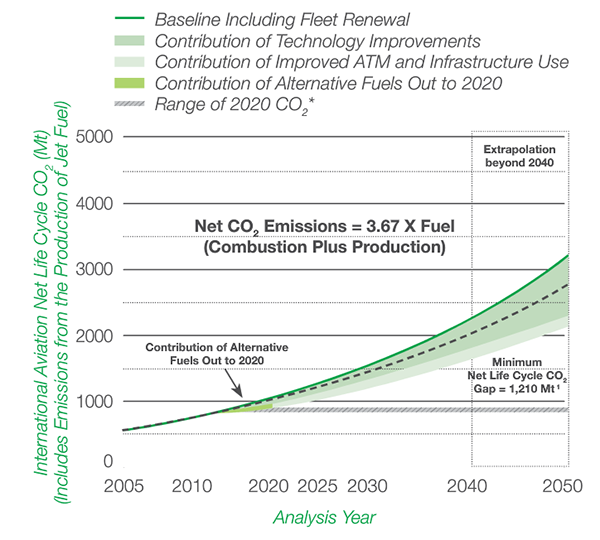
Explainer: Aviation’s battle to limit rising emissions
Sophie Yeo
06.30.15Tomorrow, the Airports Commission is expected to make its recommendation on how to expand the aviation industry in the UK.
Sir Howard Davies, the economist behind the report, has weighed up three options: a new runway at Heathrow, a new runway at Gatwick, and extending Heathrow’s northern runway.
But a question mark hangs over how the new runway would be compatible with the UK’s climate change targets, rendering it an issue of not where it should be built, but whether it should be built at all.
The UK’s dilemma is a microcosm of the global story of rapid expansion in the aviation industry, at a time when emissions need to rapidly decrease.
UK aviation emissions
Under the UK’s 2008 Climate Change Act, emissions must be reduced by 80% on 1990 levels by 2050.
In 2009, the government decided that aviation emissions must be capped at 2005 levels – 37.5 million tonnes of carbon dioxide (MtCO2) – by 2050. However, in 2012, it said it would not officially incorporate this target into its legally binding carbon budgets due to policy uncertainty at an international level.
Nonetheless, the government has informally left space within its carbon budgets to accommodate 37.5MtCO2 from the aviation sector in 2050.
Currently, aviation emissions are set to far exceed 2005 levels in 2050. Even if no new runways are built in the UK, CO2 emissions are expected to be at 47Mt in 2050, according to statistics from the Department of Transport.
Click to expand. Credit: Rosamund Pearce for Carbon Brief
Without a carbon price and if airport expansion is unconstrained, aviation demand could grow more than 200% between 2005 and 2050, the Committee on Climate Change projects.
The chart below illustrates the growth in UK international aviation emissions between 1972 and 2012.
Source: Carbon Brief, using IEA data
By the government’s own admission, expanding both Gatwick or Heathrow will push the UK beyond its target for aviation. In 2050, in a scenario where the UK meets its 37.5MtCO2 goal, Heathrow will be responsible for 16.6MtCO2, and Gatwick for 3.9MtCO2.
A new runway at Heathrow would add an extra 3.9MtCO2 to its baseline, or 1.4MtCO2 at Gatwick.
Global aviation emissions
Globally, aviation is one of the fastest growing sectors in terms of greenhouse gas emissions. According to the UN’s climate body, aviation emissions increased by 76.1% between 1990 and 2012.
Emissions from international aviation and shipping fuel (bunkers), in billions of tonnes (1,000Tg) of CO2 equivalent. Source: UNFCCC
In 2012, aeroplanes were responsible for 689MtCO2. By 2013, this had increased to 705MtCO2, according to analysis by the International Air Transport Association (IATA) of figures from the International Energy Agency (IEA).
This represents around 2% of global CO2 emissions – or around the same volume of CO2 emitted every year by Germany. This means that, if the aviation sector were a country, it would be the world’s seventh largest emitter.
Aviation’s contribution to climate change does not only lie in its CO2 emissions. Aeroplanes also emit water vapour, chemicals and other substances that can form contrails, changing the natural formation of clouds. These impact the overall energy balance of the planet, known as radiative forcing, which is what causes the global temperature to rise.
A special report into aviation by the Intergovernmental Panel on Climate Change in 1999 estimated that aeroplanes were responsible for 3.5% of total human-caused radiative forcing, excluding the impact of clouds.
International efforts
However, unlike a country, the aviation industry will not face a binding requirement to tackle its emissions at the UN climate talks in Paris this December, where a new international deal is set to be signed.
The draft of the text currently under negotiation passes responsibility for reducing aviation emissions to the International Civil Aviation Authority, a specialised agency of the UN.
ICAO has set several goals aimed at limiting and then reducing emissions from aviation. This includes the “aspirational” target of improving fuel efficiency by 2% every year, limiting emissions at 2020 levels and then reducing them to half of 2005 levels by 2050 – all non-binding.
Yet, according to ICAO’s 2013 projections, shown in the graph below, emissions from the aviation industry are set to grow 200%-360% on current levels by 2050, including the maximum use of lower-carbon alternative fuels. This is far in excess of the goal of carbon neutral growth from 2020.
ICAO projections of aviation emissions and the potential to limit growth. Source: ICAO Environmental Report 2013
ICAO’s crowning achievement would be the development of a global carbon market to limit emissions from the world’s aviation industry.
The 191 countries represented at ICAO have agreed to do this and have outlined some potential options for how such a mechanism could shape up.
One possibility is to use carbon offsets, which participants could buy to neutralise their emissions above an agreed limit. Another possibility is to do this, while simultaneously applying a charge for every tonne of CO2, generating a stream of revenue that can be used for other climate-related projects. The final possibility is to develop a cap-and-trade scheme for the industry.
But while the options are on the table, progress has been slow, held up by the inevitable political difficulties in attempting to implement the world’s first global carbon market for a certain sector.
Developing a market mechanism for aviation includes an added complication: establishing which emissions belong to which country. Some argue that countries ought to take responsibility for all emissions from the aeroplanes departing from their territory. Others say it should depend where the airline operator is registered. A third option is that countries should take responsibility for the CO2 emitted in their airspace.
At ICAO’s general assembly in 2013, countries reaffirmed that they would develop a market-based mechanism for the industry, and develop the options for doing so. A decision is due on this in 2016.
Technology
The markets offer one method of scaling down aviation emissions, but they are not the only answer. Technology, operational improvements and biofuels also offer opportunities for reducing aviation pollution.
From an operations perspective, this can mean advanced communications, navigation and surveillance, along with better air traffic management, which can reduce the amount of time that the plane spends in the air.
Technological improvements include more efficient engines, advanced lightweight materials and improved aerodynamics.
Biofuels can also be used as an alternative to traditional fuels – although the level of the benefits that they offer is contentious, due to possible competition for land with CO2-absorbing forests.
Nonetheless, developing a market-based mechanism for the aviation industry remains key if the aviation industry is going to achieve its own goals without dramatically reducing demand for flights.
These alternative approaches, known as the “basket of measures” in ICAO jargon, will not alone put the aviation industry on track to achieve carbon neutral growth after 2020, according to a paper by Professor David Lee, who leads the Centre for Aviation, Transport and the Environment at Manchester Metropolitan University.
It finds that applying new technology, advanced operational procedures, using more biofuel and extending out market mechanisms to 2050 cannot stop emissions growing. Under the maximum level of ambition that the researchers modelled, emissions would still rise to 774MtCO2 per year – more than today’s emissions of 705MtCO2.
The graph below shows the ranges of outcomes depending on how enthusiastically improvements to the industry are adopted.
Potential to reduce international aviation emissions through technology, operational improvements, biofuels and existing market-based mechanisms. Source: Bridging the aviation CO2 emissions gap
The paper concluded that no currently available measures, or any combination of them, could achieve the goal of carbon neutral growth after 2020 for any scenario of the industry’s growth. But since regional markets have reduced emissions most effectively so far, it says, a global mechanism would be the most effective means to achieve this goal in the future.
Demand
There is one other way to cut aviation emissions: reduce demand – or, at the very least, reduce the growth in demand.
Unsurprisingly, this is the less popular option among countries and industries that want to see the continued expansion of aviation.
At its 2013 general assembly, ICAO emphasised “the need to ensure that international aviation continues to develop in a sustainable manner”.
A 2014 paper published in the journal Atmospheric Environment reinforced the point that improved airline efficiency will not be able to compensate for the growth in emissions that will result from increased demand.
In order to achieve an overall reduction in CO2 from the industry, “behaviour change will be necessary to reduce demand for air-travel”, it says. Reduced demand could be brought about by an increase in ticket price of around 1.4% per year, say the authors – reversing the current trend that has seen the price of international tickets fall by 0.5% per year between 1990 and 2012.
A study released in March 2015 by the Tyndall Centre suggests that climate scientists themselves should lead the way through shunning air travel, wherever possible.
The UK’s Committee on Climate Change says that national growth in aviation demand must be limited to 60% in order to meet the government’s target of keeping emissions in 2050 at 2005 levels.
In the UK, the majority of the industry’s growth has come from holiday makers, rather than business trips. The graph below shows that growth in business flights had started to flatline even before the financial crisis of 2008.
Reasons for UK passengers travelling abroad by air. Credit: Carbon Brief, based on ONS statistics
This undermines the argument made by some, such as former Conservative MP Tim Yeo, that there is a strong business case for a third runway.
Recently, a group of individuals from tax and environmental campaigning groups wrote a letter in The Observer backing instead a “frequent flyers levy”, which would tax travellers based on how regularly they fly. They wrote:
“Our research shows that this ‘polluter pays’ approach would enable the UK to meet our climate targets without making flying the preserve of the rich – and without needing to build any new runways.”
National action
While an international mechanism to reduce aviation emissions has yet to materialise, countries are increasingly taking action at the national level.
The EU has included aviation emissions within its Emissions Trading System, facing down fierce opposition, including some US airlines, who unsuccessfully fought a case against the Commission in the European Court of Justice in 2011.
The scheme only covers flights that both takeoff and land within the EU (and Iceland, Norway and Liechtenstein). The EU agreed to exclude international flights entering its airspace, in the hope that it would ease political tension and facilitate an agreement on a global market mechanism in 2016.
The US Environmental Protection Agency recently acknowledged the role of aviation emissions in causing global warming, and said it will develop rules in line with ICAO regulation to reduce emissions from the industry, as it has done for vehicles and power plants.
But while the EU, in particular, has shown leadership on this issue, national actions alone cannot tackle the enormous growth of the industry, and cannot compensate for the particularly fierce growth in developing countries. The burden to act first falls on developed countries, with ICAO recognising the UN principle of “common but differentiated responsibilities”.
For instance, between 1990 and 2012, emissions from the aviation industry grew 913% in Benin, 800% in Mongolia and 500% in Nepal. This compares to growth of 10% in Canada, 63% in the US and 84% in Germany.
Source: Carbon Brief, using IEA data
Covered by only weak regulation, and with the prospect of future reductions still shadowy, aviation is one of the most difficult issues of climate change policy. The methods to significantly reduce its emissions – a global market mechanism, or simply flying less – are unpopular and difficult to implement.
If the UK government decides to give the go-ahead for a new runway, it will find it has a difficult task ahead in proving that it is not part of the problem.







